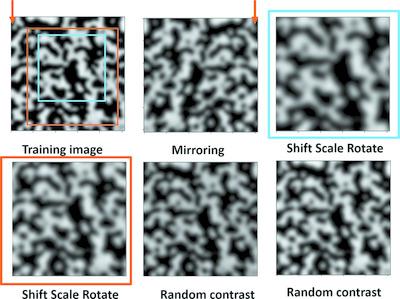当前位置:
X-MOL 学术
›
J. Synchrotron Radiat.
›
论文详情
Our official English website, www.x-mol.net, welcomes your feedback! (Note: you will need to create a separate account there.)
Automatic segmentation for synchrotron‐based imaging of porous bread dough using deep learning approach
Journal of Synchrotron Radiation ( IF 2.5 ) Pub Date : 2021-02-18 , DOI: 10.1107/s1600577521001314 Salah Ali , Sherry Mayo , Amirali K. Gostar , Ruwan Tennakoon , Alireza Bab-Hadiashar , Thu MCann , Helen Tuhumury , Jenny Favaro
Journal of Synchrotron Radiation ( IF 2.5 ) Pub Date : 2021-02-18 , DOI: 10.1107/s1600577521001314 Salah Ali , Sherry Mayo , Amirali K. Gostar , Ruwan Tennakoon , Alireza Bab-Hadiashar , Thu MCann , Helen Tuhumury , Jenny Favaro

|
In recent years, major capability improvements at synchrotron beamlines have given researchers the ability to capture more complex structures at a higher resolution within a very short time. This opens up the possibility of studying dynamic processes and observing resulting structural changes over time. However, such studies can create a huge quantity of 3D image data, which presents a major challenge for segmentation and analysis. Here tomography experiments at the Australian synchrotron source are examined, which were used to study bread dough formulations during rising and baking, resulting in over 460 individual 3D datasets. The current pipeline for segmentation and analysis involves semi‐automated methods using commercial software that require a large amount of user input. This paper focuses on exploring machine learning methods to automate this process. The main challenge to be faced is in generating adequate training datasets to train the machine learning model. Creating training data by manually segmenting real images is very labour‐intensive, so instead methods of automatically creating synthetic training datasets which have the same attributes of the original images have been tested. The generated synthetic images are used to train a U‐Net model, which is then used to segment the original bread dough images. The trained U‐Net outperformed the previously used segmentation techniques while taking less manual effort. This automated model for data segmentation would alleviate the time‐consuming aspects of experimental workflow and would open the door to perform 4D characterization experiments with smaller time steps.
中文翻译:

使用深度学习方法对基于同步加速器的多孔面包面团进行自动分割
近年来,同步加速器光束线的重大功能改进使研究人员能够在很短的时间内以更高的分辨率捕获更复杂的结构。这开辟了研究动态过程并观察随时间变化导致的结构变化的可能性。但是,此类研究可以创建大量的3D图像数据,这对分割和分析提出了重大挑战。这里检查了澳大利亚同步加速器源的层析成像实验,该实验用于研究面包在烘烤过程中的面团配方,产生了460多个单独的3D数据集。当前的细分和分析管道涉及使用商业软件的半自动化方法,这些方法需要大量用户输入。本文专注于探索机器学习方法以使这一过程自动化。面临的主要挑战是生成足够的训练数据集来训练机器学习模型。通过手动分割真实图像来创建训练数据非常费力,因此已经测试了自动创建具有与原始图像相同属性的合成训练数据集的方法。生成的合成图像用于训练U-Net模型,然后将其用于分割原始的面包面团图像。训练有素的U-Net优于以前使用的分割技术,同时减少了人工操作。
更新日期:2021-03-04
中文翻译:

使用深度学习方法对基于同步加速器的多孔面包面团进行自动分割
近年来,同步加速器光束线的重大功能改进使研究人员能够在很短的时间内以更高的分辨率捕获更复杂的结构。这开辟了研究动态过程并观察随时间变化导致的结构变化的可能性。但是,此类研究可以创建大量的3D图像数据,这对分割和分析提出了重大挑战。这里检查了澳大利亚同步加速器源的层析成像实验,该实验用于研究面包在烘烤过程中的面团配方,产生了460多个单独的3D数据集。当前的细分和分析管道涉及使用商业软件的半自动化方法,这些方法需要大量用户输入。本文专注于探索机器学习方法以使这一过程自动化。面临的主要挑战是生成足够的训练数据集来训练机器学习模型。通过手动分割真实图像来创建训练数据非常费力,因此已经测试了自动创建具有与原始图像相同属性的合成训练数据集的方法。生成的合成图像用于训练U-Net模型,然后将其用于分割原始的面包面团图像。训练有素的U-Net优于以前使用的分割技术,同时减少了人工操作。



























 京公网安备 11010802027423号
京公网安备 11010802027423号